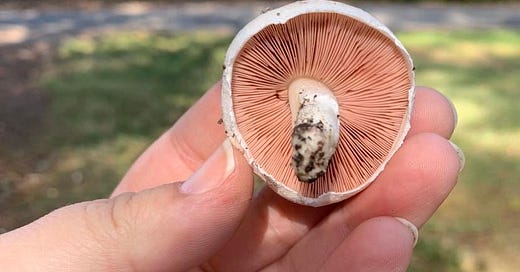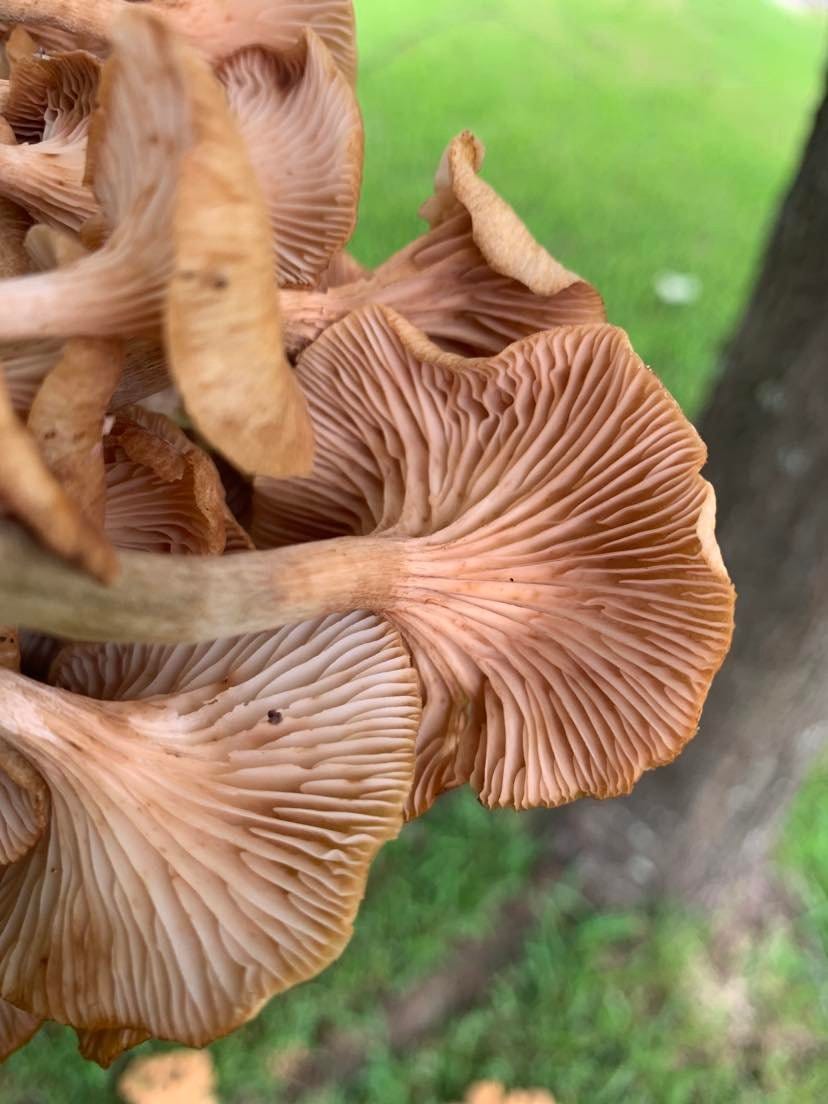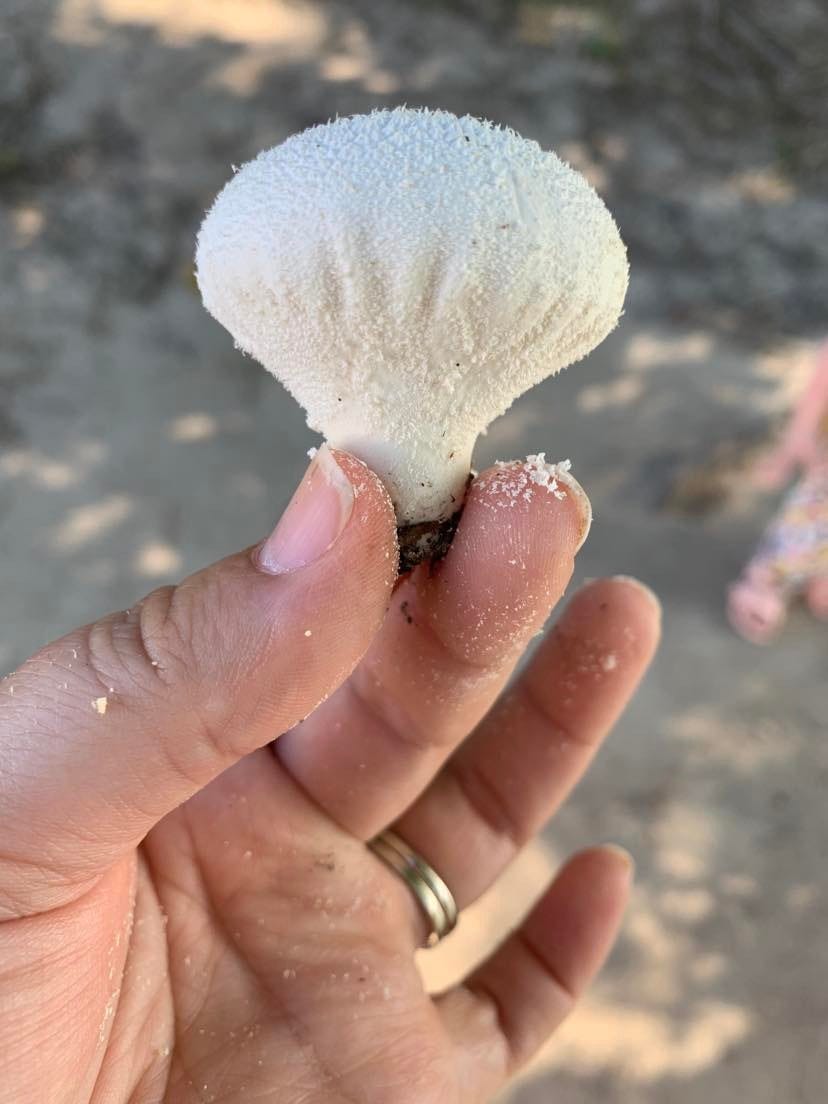Hi! By some stroke of luck you’re reading, “Yes, I Am A Hungry Woman.” Have you subscribed?
I wish I knew about poisonous mushrooms.
Well, I wish I knew about which ones weren’t poisonous and which ones were, and how to tell the difference so as to Spare My Internal Organs the agony (and possible death). Mushrooms have fascinated me for years, long before they became trendy. Everybody likes mushrooms now the way everybody liked owls and foxes in the late aughts/early 2010s. I expect in a few years mushrooms will go back out of style and only the strange, mossy, curious, foraging types will care about them anymore. And me. I’ll still care. I’ve always cared
Ever since I was little, I’ve been deeply curious about learning the names of the wild things around me; more especially if I could tell if they were edible. And although it has now been years since I’ve lived out in the country, I still find most of that information springing to mind like a pre-flight checklist, wherever I take walks. My brain marks each plant as I pass it, both identifying and admiring them for their beauty and their useful qualities:
Beautyberry, edible; its leaves can be used to repel insects.
Redbud, edible.
Sumac, edible.
Mimosa blossoms, edible.
Butterfly pea, edible.
Asiatic day flower, edible.
Lady’s thumb, edible.
Tiger lilies: edible blossoms and edible tuberous roots which taste like potatoes or turnips.
Asters, goldenrod...blossoms of both make a nice tea.
Plantain, edible, and good for burns or stings.
Dandelion, edible.
Chickweed, edible.
Jewelweed, good for poison ivy, which it often grows beside. Edible blossoms and delightfully edible seeds which spring out of a jack-in-the-box pod with the slightest touch. The seeds taste of walnuts.
Partridge berry, edible.
Wild blackberry, edible.
Scuppernong grapes, edible.
Wild cherry, edible.
Jerusalem artichoke, edible potato-like roots.
Pokeweed, mostly inedible. All except the youngest, lightest green shoots.
Honeysuckle, edible.
My brain recites these like a catechism as I wend my way on urban sidewalks, park paths, and wild trails. I just like to know, you know? And while I can’t identify every tree and plant I see, I feel like I can read the landscape around me, know where I belong in it, and know what I could access from it if I needed to. I love that feeling.
Once, as we hiked along the James River, I posed a question to my family: what would you cook if we were on a survival show and you had to come up with dinner? I opted for hypothetical clams wrapped in seaweed, steamed and eaten with fresh greens from the sandy bank above the river. I knew I could pull that off if I ever needed to; the potential of my ability satisfies me.
My knowledge of edible wild things, however, does not extend to mushrooms. When it comes to mushrooms, I am illiterate. If I can read a book in the trees and plants of Southeastern Virginia, I am not even hooked on phonics in the category of mushrooms. I am frustrated by this in the same way that the child I nanny (nearly three years old) is frustrated by her inability to read, despite her ability to recognize that shapes of letters pair with the Alphabet Song. She runs her fingers down pages of books, singing the ABCs and willing meaning to come out of those mysterious words and sentences. She memorizes books we’ve read together many times and recites them to herself, cleverly memorizing exactly which words belong to exactly which page to approximate actual reading.
But she’s a toddler. She can’t read.
And I can’t identify mushrooms.
This doesn’t stop me from trying. It has only (so far) stopped me from trying to eat any of the mushrooms I think I’ve found. For years I thought that simply touching a poisonous mushroom or breathing in its spores would kill me. Therefore, I was scared to touch any mushroom. Now I understand that it’s ingesting toxic mushrooms that is the problem, and that mushroom hunters are fairly safe in picking all of their supposedly-edible mushrooms together in the same basket and sorting out the imposters later. This fascinated and liberated me. You mean, I can pick, dissect, break apart, sniff, and touch any mushroom without much danger of falling over dead the next minute? (Not that you want to sniff just any mushroom - dog stinkhorns are famous for smelling foul, as per their name. They also look shockingly disturbed: slender spires of red and slimy brown, hunching over as they age and sending up the scent of rotted meat.)
Freed from my fear of touching mushrooms, I am now entering my Age of Exploration, of trying to learn how to parse this bit of the natural world I inhabit.
It’s slow going.
A couple years ago I signed up for a mushroom hunting class at a local park. On a crisp October morning, I showed up to a small brown building in a stand of pines. With me were a number of other mushroom enthusiasts - a surprisingly stout turnout for a cold Saturday morning. We huddled around a pot of weak coffee and munched waxy chocolate doughnuts till the class began. It was taught by one of Norfolk Botanical Gardens’ mycologists: a woman who looked like Ms. Frizzle of The Magic Schoolbus and spoke energetically of mycelium, caps, lamellae, stems, fruiting bodies, as if we were all several semesters into getting a college degree in mycology. I loved it.
Dressed in forest-colored khakis and gesturing to the projector slides behind her, she finished her talks about the science-y bits of mushrooms by putting the fear of God in us about eating foraged mushrooms. She herself never ate them. You might be correct in your identification but if you’re not, she warned, your organs fail one by one and just when you feel like you might be recovering, that’s when you die.
All a very cheerful prognosis for the amateur mushroom hunter I want to become.
My main takeaway (besides some nifty diagrams of the mushroom that were passed out toward the class’s end) was that there is a type of safe, edible mushroom that will, however, put you in a coma if you accidentally pair it with wine. Its safety-or-not literally hinges on your recollection of this obscure fact in the exact moment of being handed a glass of pinot as you cook with friends after a day out foraging.
I raised my hand. The instructor called on me.
“Is it only problematic if you eat these mushrooms and drink a glass of wine?” I asked, being a non-drinker and therefore safe, “Or would I go into a coma if I made, say, a pasta with mushrooms and a buttery white wine sauce to go over top?”
She looked a tad nervous, probably being unaccustomed to follow-up questions on a simple Fun Fact.
I tipped my head to one side, warming to my subject and really wanting to confirm this detail before we headed outside: “Of course the alcohol from the wine would have simmered out of the sauce by the time you’d serve the pasta so maybe it would be all right. Or is the mushroom reacting to the wine’s other chemistry, and not the alcohol?”
“I’m really not certain,” the mycologist said, looking uncomfortable at this line of questioning, “but I think leaving wine out of the picture altogether would be safest.”
I headed outdoors with the others in the group, relieved of the pressure of “edible or not” by the teacher’s adamant claim that nobody would be eating any foraged mushrooms today. We were to find as many types of mushrooms and fungus as possible and simply observe them. Their color, their shape, their location. If a literal professional mycologist is afraid to eat foraged mushrooms then should I? Should any of us?
I wasn’t plagued by mycophobia before this class, but the instructor’s insistence on reminding us of fatal dinner parties sure did light some sparks of it within me.
Outside, I paired up with a quiet, stiff sort of woman and her young son who seemed to know what they were doing, seemed to want to be away from the rest of the class in the manner of people who Already Know This Stuff.
After a determined bit of conversation on my part, I learned that this woman had been a mushroom hunter all her life, taught by her European grandfather, and she did Know Things. Not only was she adept in foraging for mushrooms, but she’d been eating wild mushrooms her whole life and still standing to tell the tale. The proof was in the pudding: this is someone whose knowledge was sound enough, it hadn’t killed her yet. I practically demanded her phone number at the end of the morning, and made her promise to take me foraging. Then, because life is like that sometimes, time passed, I forgot her name, and the only person who might have been confident and practiced enough to teach me how to forage, disappeared forever from my grasp.
In the time since that class, I’ve learned a bit more. I bought a mushroom kit and spent an enchanting week watching pink oysters bud and bloom from the sawdust into several pounds of rosy ruffles. I’ve paid attention to the wild mushrooms that grow in my area. I’ve broken them apart, smelled them, bruised them to see if the flesh changes color. I’ve made spore prints. Split them in half vertically. Checked out the gills. Learned the difference between most other mushrooms and spongy boletes. I’ve aligned myself with hobbits, who love mushrooms and are successful at hunting them. I’ve spent time online researching which vague, pale brown mushroom this one might be, and how it differs from that one. I’ve checked books out from the library, and watched mycology documentaries. I’ve tried to learn about mushrooms and how to forage them but really? The only thing I’m confident about is that I’m not confident.
Yes, this is a puffball. Yes, it’s young and the flesh is white all the way through and yes that means I ought to be able to eat it. But what if it kills me? What if that’s the last time I can ever be wrong in this life, because I die?
I’m pretty sure I passed up a once-in-a-lifetime flock of white oyster mushrooms last year because I wasn’t sure.
I know I found some tiny jelly-ears this week.
I am almost certain that the front yard at work was full of honey mushrooms a month ago.
One of my favorite children’s novels is Jean Craighead George’s My Side Of The Mountain. There is one passage I often reflect upon: the main character, Sam, has finally been brave enough to cook puffball mushrooms; after dinner he lies awake all night wondering how long it will be before he dies from such an idiotic decision. (He doesn’t die - they were puffball mushrooms and yes, in their young stages they are edible).
I relate to that passage because it is the exact same state of mind toward wild mushrooms that I currently occupy: I think I know, but I’m worried I actually don't.
I’ve been staring at the illegible world of it, running my fingers down its pages to try to will myself into knowing how to read. I hate that I recognize the shapes of its letters and can sing its ABCs and still am not any closer to being literate. I feel as if I’ve come to a certain crossroads: I know about as much as I guess I’ll ever be comfortable knowing without the aid of a forager who will teach me how. Perhaps if I was less of a hands-on learner, I’d feel more confident in just running with the knowledge I’ve gained from books and articles and field guides and Paul Stamets and my great willpower to learn by osmosis from the forest.
But you can’t just approach mushrooms with giddy glee. So here we are.
I have hopes that in a few more years, I will have found someone who will take me under their wing and show me the way to chicken of the woods, and great tufts of lion’s mane, and maybe even some lobster mushrooms. It is my great dream to find a chanterelle and know it’s a chanterelle and not a toxic, glow-in-the-dark Jack O’ Lantern. I have hopes that I’ll one day become someone who has the knack for plucking some pine-cone-looking mushroom out of the leaf litter on the forest floor, knocking a bit of soil from its base with my grubby thumb, and saying, “Such a great day for hunting morels. Best season in years.”
But now? I’m just a girl, standing in front of the internet, asking someone to teach her how to mushroom. The stakes feel way too high to be self-taught this time.
Are you the one who can teach me?





